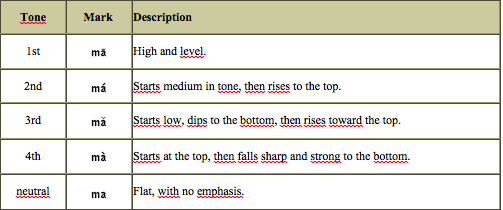"Chinese is a tonal language."

This sentence has confounded millions of you, no doubt. To clarify, we don't mean that pronouncing the same word, or character, in different tones affects its meaning.
Instead, we mean that the tone for each Chinese character is, for lack of a better word, assigned.
Mandarin has four tones--five if you count the "neutral" tone--and as you'll see below, pronouncing the tone just right is very important.
Written characters don't reveal their initials and finals, nor do they indicate which tones they are to be pronounced in.
Tones also have nothing to do with parts of speech or any other variable. Each character's "assigned" tone is simply learned when you study or "acquire" Chinese.
The four tones are usually depicted graphically with the accompanying chart, to show "where" each one occurs in tonal space.
The following table illustrates tone markings above the sound ma and describes how each tone is vocalized:
 
Here are a couple points to keep in mind as you soak in the table just above:
• The four tone markings used in Pinyin were borrowed from the Yale system.
• The Wade-Giles system places a 1, 2, 3, or 4 after each syllable to indicate its tone.
And this is very important: If you use the wrong tones, your listeners may not be able to understand you. Those of us who studied Chinese in Chinese-speaking regions remember quite well the frustration of not being understood early on simply because our tones were a little off.
These misunderstandings are possible because some terms with unrelated meanings may have the same initial and final combinations, but different tones.
It gets even more challenging. Many terms with completely unrelated meanings have the same initial sounds, final sounds and assigned tones. In other words, two words that are pronounced the same may have meanings as different as night and day. Or at least, in the case of míng, as different as dark () and bright ().
If this seems too overwhelming, just remember the difficulties speakers of other languages have early on with the English homonyms to, too, and two…
|